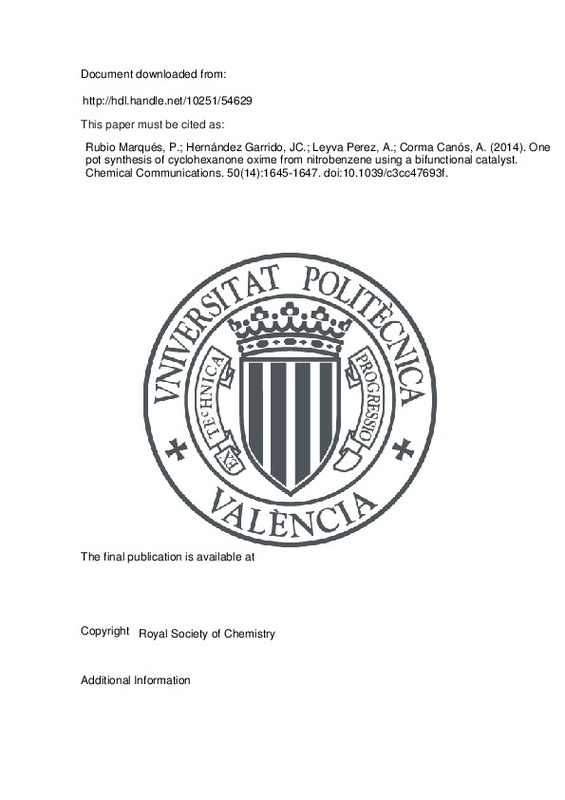Ichihashi, H., & Sato, H. (2001). The development of new heterogeneous catalytic processes for the production of ε-caprolactam. Applied Catalysis A: General, 221(1-2), 359-366. doi:10.1016/s0926-860x(01)00887-0
Calderon-Moreno, J. M., Pol, V. G., & Popa, M. (2011). Single-Step Synthesis of Ruthenium Catalytic Nanocrystallites in a Stable Carbon Support. European Journal of Inorganic Chemistry, 2011(18), 2856-2862. doi:10.1002/ejic.201001360
Mokaya, R., & Poliakoff, M. (2005). A cleaner way to nylon? Nature, 437(7063), 1243-1244. doi:10.1038/4371243a
[+]
Ichihashi, H., & Sato, H. (2001). The development of new heterogeneous catalytic processes for the production of ε-caprolactam. Applied Catalysis A: General, 221(1-2), 359-366. doi:10.1016/s0926-860x(01)00887-0
Calderon-Moreno, J. M., Pol, V. G., & Popa, M. (2011). Single-Step Synthesis of Ruthenium Catalytic Nanocrystallites in a Stable Carbon Support. European Journal of Inorganic Chemistry, 2011(18), 2856-2862. doi:10.1002/ejic.201001360
Mokaya, R., & Poliakoff, M. (2005). A cleaner way to nylon? Nature, 437(7063), 1243-1244. doi:10.1038/4371243a
Stahl, S. S. (2005). CHEMISTRY: Palladium-Catalyzed Oxidation of Organic Chemicals with O2. Science, 309(5742), 1824-1826. doi:10.1126/science.1114666
Thomas, J. M., Raja, R., Sankar, G., & Bell, R. G. (1999). Molecular-sieve catalysts for the selective oxidation of linear alkanes by molecular oxygen. Nature, 398(6724), 227-230. doi:10.1038/18417
Matos, J., & Corma, A. (2011). Selective phenol hydrogenation in aqueous phase on Pd-based catalysts supported on hybrid TiO2-carbon materials. Applied Catalysis A: General, 404(1-2), 103-112. doi:10.1016/j.apcata.2011.07.018
Liu, H., Jiang, T., Han, B., Liang, S., & Zhou, Y. (2009). Selective Phenol Hydrogenation to Cyclohexanone Over a Dual Supported Pd–Lewis Acid Catalyst. Science, 326(5957), 1250-1252. doi:10.1126/science.1179713
Sikhwivhilu, L. M., Coville, N. J., Naresh, D., Chary, K. V. R., & Vishwanathan, V. (2007). Nanotubular titanate supported palladium catalysts: The influence of structure and morphology on phenol hydrogenation activity. Applied Catalysis A: General, 324, 52-61. doi:10.1016/j.apcata.2007.03.004
Rode, C. V., Joshi, U. D., Sato, O., & Shirai, M. (2003). Catalytic ring hydrogenation of phenol under supercritical carbon dioxide. Chemical Communications, (15), 1960. doi:10.1039/b304344d
Suzuki, K., Watanabe, T., & Murahashi, S.-I. (2008). Aerobic Oxidation of Primary Amines to Oximes Catalyzed by DPPH and WO3/Al2O3. Angewandte Chemie International Edition, 47(11), 2079-2081. doi:10.1002/anie.200705002
Thomas, J. M., & Raja, R. (2005). Design of a «green» one-step catalytic production of -caprolactam (precursor of nylon-6). Proceedings of the National Academy of Sciences, 102(39), 13732-13736. doi:10.1073/pnas.0506907102
Sato, K. (1998). A «Green» Route to Adipic Acid: Direct Oxidation of Cyclohexenes with 30 Percent Hydrogen Peroxide. Science, 281(5383), 1646-1647. doi:10.1126/science.281.5383.1646
Climent, M. J., Corma, A., & Iborra, S. (2011). Heterogeneous Catalysts for the One-Pot Synthesis of Chemicals and Fine Chemicals. Chemical Reviews, 111(2), 1072-1133. doi:10.1021/cr1002084
Nicolaou, K. C., Edmonds, D. J., & Bulger, P. G. (2006). Cascade Reactions in Total Synthesis. Angewandte Chemie International Edition, 45(43), 7134-7186. doi:10.1002/anie.200601872
(s. f.). doi:10.1021/cr950023
Shin, J. Y., Jung, D. J., & Lee, S. (2013). A Multifunction Pd/Sc(OTf)3/Ionic Liquid Catalyst System for the Tandem One-Pot Conversion of Phenol to ε-Caprolactam. ACS Catalysis, 3(4), 525-528. doi:10.1021/cs400009w
Grirrane, A., Corma, A., & Garcia, H. (2008). Gold-Catalyzed Synthesis of Aromatic Azo Compounds from Anilines and Nitroaromatics. Science, 322(5908), 1661-1664. doi:10.1126/science.1166401
Corma, A., Concepción, P., & Serna, P. (2007). A Different Reaction Pathway for the Reduction of Aromatic Nitro Compounds on Gold Catalysts. Angewandte Chemie International Edition, 46(38), 7266-7269. doi:10.1002/anie.200700823
Corma, A. (2006). Chemoselective Hydrogenation of Nitro Compounds with Supported Gold Catalysts. Science, 313(5785), 332-334. doi:10.1126/science.1128383
Guillena, G., Ramón, D. J., & Yus, M. (2009). Hydrogen Autotransfer in theN-Alkylation of Amines and Related Compounds using Alcohols and Amines as Electrophiles. Chemical Reviews, 110(3), 1611-1641. doi:10.1021/cr9002159
Hollmann, D., Bähn, S., Tillack, A., & Beller, M. (2008). N-Dealkylation of aliphatic amines and selective synthesis of monoalkylated aryl amines. Chemical Communications, (27), 3199. doi:10.1039/b803114b
Hollmann, D., Bähn, S., Tillack, A., & Beller, M. (2007). A General Ruthenium-Catalyzed Synthesis of Aromatic Amines. Angewandte Chemie International Edition, 46(43), 8291-8294. doi:10.1002/anie.200703119
Barluenga, J., Jiménez-Aquino, A., Aznar, F., & Valdés, C. (2009). Modular Synthesis of Indoles from Imines ando-Dihaloarenes oro-Chlorosulfonates by a Pd-Catalyzed Cascade Process. Journal of the American Chemical Society, 131(11), 4031-4041. doi:10.1021/ja808652a
Zhang, X., & Corma, A. (2008). Supported Gold(III) Catalysts for Highly Efficient Three-Component Coupling Reactions. Angewandte Chemie, 120(23), 4430-4433. doi:10.1002/ange.200800098
Shimizu, K., Yamamoto, T., Tai, Y., & Satsuma, A. (2011). Selective hydrogenation of nitrocyclohexane to cyclohexanone oxime by alumina-supported gold cluster catalysts. Journal of Molecular Catalysis A: Chemical, 345(1-2), 54-59. doi:10.1016/j.molcata.2011.05.018
Jeyabharathi, C., Senthil Kumar, S., Kiruthika, G. V. M., & Phani, K. L. N. (2010). Aqueous CTAB-Assisted Electrodeposition of Gold Atomic Clusters and Their Oxygen Reduction Electrocatalytic Activity in Acid Solutions. Angewandte Chemie International Edition, 49(16), 2925-2928. doi:10.1002/anie.200905614
Sinha, A. K., Basu, M., Sarkar, S., Pradhan, M., & Pal, T. (2013). Synthesis of gold nanochains via photoactivation technique and their catalytic applications. Journal of Colloid and Interface Science, 398, 13-21. doi:10.1016/j.jcis.2013.01.061
Oliver-Meseguer, J., Cabrero-Antonino, J. R., Dominguez, I., Leyva-Perez, A., & Corma, A. (2012). Small Gold Clusters Formed in Solution Give Reaction Turnover Numbers of 107 at Room Temperature. Science, 338(6113), 1452-1455. doi:10.1126/science.1227813
[-]







![[Cerrado]](/themes/UPV/images/candado.png)


